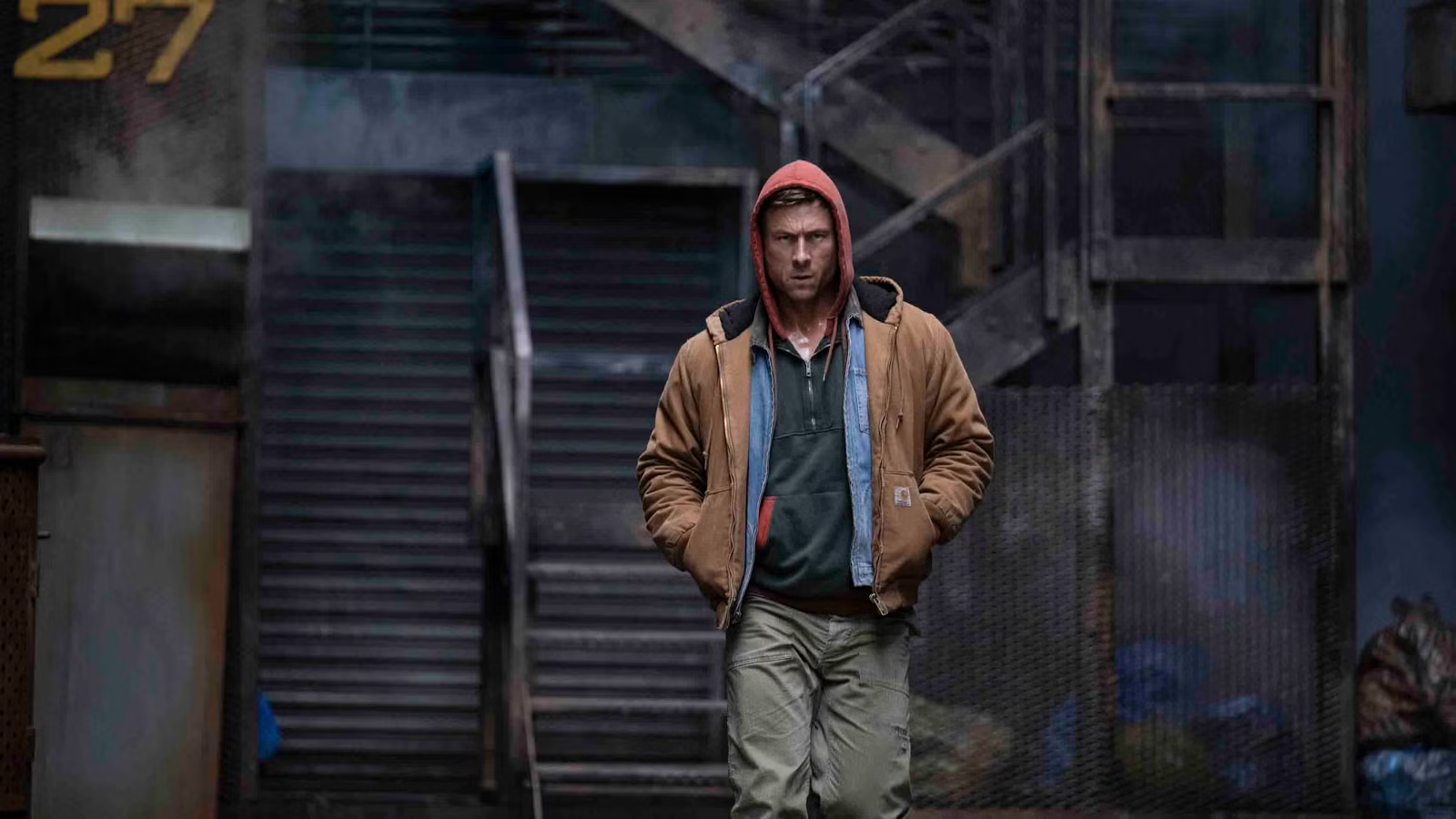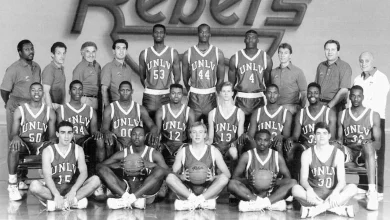Where was Edgar Wright in the Stephen King adaptation The Running Man?

Edgar Wright has been one of pop culture’s most idiosyncratic voices since the beginning of his feature-film career. He’s a restless joker who leaps from genre to genre, bringing along a visible love of each new pocket of culture he slides his hands into, along with an irreverent sense of parody that helps make those genres feel new again. Audiences go into a Wright movie with no idea what to expect, apart from his signature style elements: aggressively snappy editing, endless winking musical needle-drops, and above all, a sense that Wright wants to interrogate whatever new genre he’s working in (the zombie movie, the police mystery, the body-snatcher movie, etc.), find its limits, and reinvent it in a smarter, sharper form.
So how, then, to explain The Running Man, Wright’s adaptation of Stephen King’s 1982 novel about a predatory, lethal game show? For roughly the first two-thirds of its running time (so to speak), Wright’s version of The Running Man plays the story straight — at least, more surface-level and sincere than his best movies, which typically bring the audience in on the joke early and often. And then the film goes entirely off the rails, to the point where it stops feeling like an Edgar Wright movie altogether, and starts looking like a story mandated by studio execs with no sense of humor at all.
Image: Paramount Pictures
Top Gun: Maverick and Hit Man star Glen Powell takes center stage as Ben Richards, the angriest man in a fury-inducing near future where (if you can believe it) the massive divide between the rich and the poor has led to a desperate underclass willing to do anything for money. One route out of oppressive poverty is the Free-Vee Network, seemingly the nation’s only remaining broadcaster, which runs a series of cruel game shows where people can win money by risking their health or even their lives.
Desperate for medicine for his sick toddler, Richards auditions for the Network’s game shows. Tellingly named mogul Dan Killian (Josh Brolin, continuing the 2025 win streak that started with Weapons and will end with Knives Out 3) takes one look at Richards’ seething, righteous frustration and decides he’d make a perfect fall guy for The Running Man, a popular show where players try to evade the Network’s trained killers for 30 days, racking up cash prizes as they go. Richards’ options to save his child are limited enough that he takes the offer — and immediately finds out the game is rigged. Killian, Running Man host Bobby T (Colman Domingo), and the producers collude to present Richards and his fellow competitors as conniving, lazy, greedy criminals looking for a quick payday, so the show’s rabid fandom can feel good about seeing the hunters gun them down.
There’s an openly video game-esque form to the basic plot of The Running Man, which King wrote (under the pseudonym Richard Bachman) at the height of the golden age of arcade games. Richards has to face an escalating series of murderous challenges, while accruing enough support along the way to beat the final boss in a definitive enough way to take down his entire corrupt empire. But while the 1987 adaptation of King’s book, starring Arnold Schwarzenegger as Richards, leaned into that aspect of the story, with gleefully ridiculously, gimmick-driven hunters straight out of a Street Fighter or Mortal Kombat game (one of them was even named Subzero), Wright and co-writer Michael Bacall (Scott Pilgrim Vs. the World, 21 Jump Street) veer away from a game-esque interpretation toward something more openly commenting on current events.
Image: Paramount Pictures
There are plenty of open, obvious parallels in the way Killian and company manipulate footage of Richards with deepfakes to turn the crowd against him, the way income inequity (and lack of affordable family health care) drives Richards’ willingness to play the game in the first place, even the specifics of the hunters’ noticeably ICE-esque face masks, proto-military aesthetic, and public anonymity. But Wright’s approach with Running Man largely lacks his usual personal touch, the sense of humor that would mock this fascist regime and make it look foolish, or the insight that would take the portrayal of dystopian oppression up a notch past the usual action-movie setting that drives this style of story.
There are hints of Wright’s boundary-pushing and signature style here and there. There’s certainly some humor in a sequence where the hunters arrive for Richards while he’s headed to the communal shower in a run-down hostel; he has to fight and climb his way back to his room first in only a towel, then bare-ass naked. A little later, Richards gets some help from an underground revolutionary who’s been exposing the Network’s lies via a series of videotape vlogs that bring in some of Wright’s playful verve.
The Running Man TV show itself has visual and conceptual over-the-top parodic elements that mock this sort of reality TV. One of the Network’s other shows — a Keeping Up with the Kardashians/Real Housewives-style lifestyle-porn series called The Americanos — adds some acerbic humor, and Michael Cera (who starred in Scott Pilgrim Vs. the World) shows up in a significant yet fairly silly role. Please Don’t Destroy member Martin Herlihy also gets a memorable extended cameo that counts as Running Man’s clearest push toward comedy.
Image: Paramount Pictures
What’s missing throughout the film, though, is the strong sense of Wright’s presence that shows up in his other work, from the blistering opening-montage storytelling of Hot Fuzz to the endlessly hilarious video game sound and visual design in Scott Pilgrim to the musical action in Baby Driver to the dazzling time-jump dance in Last Night in Soho. That version of Wright only turns up in small snatches in Running Man, via a gonzo fish-eye-lens video commentary from Richards, or a quick montage of pages of an underground zine meant to kick off an anti-Network revolution if Richards survives his game. Most of The Running Man lacks any kind of strong visual distinction, in the shot choices or the editing.
And the film never fully gels, either as a righteous piece of eat-the-rich pop-culture escapism, or as sharper cultural commentary. The action beats are familiar and predictable. The small touches of futuristic world-building (like the Network’s hovering camera/gun drones) are minimal, understated, and generic, never used cleverly or to a larger point. Powell turns in a winning, sympathetic, and certainly game performance as Richards, a man pushed to the brink by his limited options and the need to protect his family. But while the early going does a convincing job of painting him as both dangerously angry and dangerously kind, prone to helping other people in ways that consistently get him into trouble, he becomes more and more anonymous and standard-issue-action-hero as the story goes on.
Maybe the most baffling aspect of The Running Man for longtime Wright fans is its lack of a particularly distinctive or surprising soundtrack. Google “best needle-drops,” and you won’t just get ranked lists poring through Wright’s most memorable screen examples, you’ll get endless lists citing him as the master of the well-timed, unexpected musical cue, inserting familiar, unlikely, yet perfect pop songs into the middle of scenes in ways that bring in extra energy and surprising humor. That aspect of Wright’s work is missing from Running Man, and it’s sorely missed.
Image: Paramount Pictures
The film’s final act is particularly baffling, and feels like it was pieced together in a hurry from studio mandates, audience testing, some highly literal modernizations of beats from King’s book, and a few half-assed ideas that don’t ever fit together. Public sentiment shifts toward Richards in a way that’s certainly understandable and even likely, but never quite feels real or meaningfully justified on-screen. Lee Pace emerges as a secondary villain, too late and too lightly to distinguish him as a meaningful player. CODA’s Emilia Jones collides with Richards in an extended role that seems designed to set up important plot events, but comes to absolutely nothing.
A ridiculously rushed finale raises endless questions on the way to what’s meant to be a cathartic resolution. None of it is satisfying, especially compared to Wright’s usual control of his narrative and his messaging. There’s a strong sense that some of these elements were introduced, then curtailed before they could really get going, as if the story could have been about how Jones’ character opens up new tactical possibilities for Richards, or how Richards builds a populist following and takes control of the propaganda machine, or how Pace’s villain defines what The Running Man has become, and is surprised when the definitions change around him. Instead, it’s about none of those things. Every strong, definitive thought in the movie peters out before solidifying, with Richards bouncing between them like a pinball, all but disappearing amid the conflicting threads.
There’s a sense throughout all of this that The Running Man was meant to be, if not edgy, then at least edged — a poignant, immediately relevant commentary on modern media manipulation, bread-and-circuses distractions, and the importance of collective action against predatory billionaires and their propaganda machines. And there’s just as much sense that any edge this movie could have had was blunted by an unwillingness to come to terms with any of those ideas, except in the most fantasy-driven, cartoonish, safe ways possible. Edgar Wright has built his reputation on steering his movies into unlikely, exciting places. In The Running Man, it rarely feels like anyone’s hand is on the wheel.
The Running Man opens in theaters on Nov. 14.





